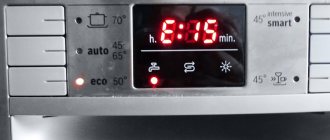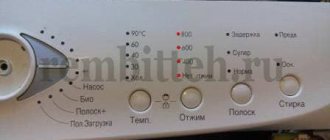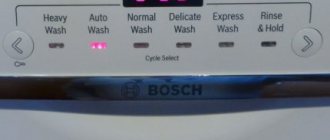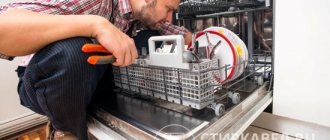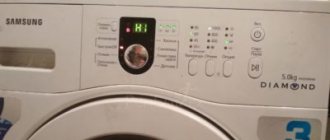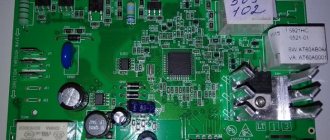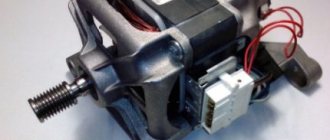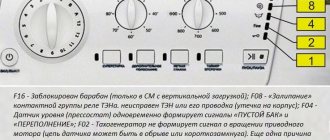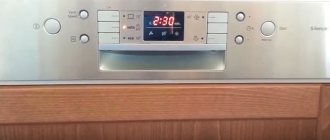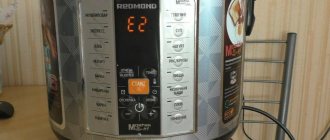No matter how carefully we treat household appliances and equipment, they all tend to break. And, as a rule, this happens at the most inopportune moment. Among other “household helpers,” dishwashers are often used. Depending on the manufacturer, operating conditions and proper use, the equipment lasts for the prescribed period or even longer. A number of reasons can cause a breakdown, as indicated by the device. So, for example, the main errors of the Korting dishwasher consist in the supply or drainage of water, failure of sensors.
Reasons for device malfunction
The main factor in failure is time. Despite the fact that the declared service life of a machine is on average 7-10 years, you can see the error code on the display much earlier. If this happens during the warranty period, the service center will send a specialist to repair it, otherwise the repair will fall on the shoulders of the owners.
Any dishwasher has a “weak spot”, as a rule, it is connected with the water supply pump. The fact is that its hardness is quite high, the presence of impurities and chlorine weakens and clogs the parts of the dishwasher. Power outages cause malfunctions in the electronics of the machine.
Manufacturers' warranties allow owners not to worry about repairs and continued serviceability of the dishwasher. But any user will need to decipher the codes. To explain the reasons for a breakdown or repair if the warranty period has expired, you should present the scale of the problem that has arisen and how to eliminate it. If the error is in the supply of washer mixture, then most likely you can fix it yourself.
How to disassemble a dishwasher
So, you can fix equipment problems either by repairing parts or replacing them with new ones. To do this, you should disassemble the dishwasher according to the following scheme:
- Disconnect the plug from the socket;
- Shut off the water supply to the water pipe to which the inlet hose is screwed, then unscrew the securing clamps;
- Prepare a floor bucket and rags in case there is water left inside the machine;
- Remove all containers for dishes from the machine hopper;
- Carefully place the machine on its side;
- Using a screwdriver and wrenches, unscrew the fixing screws holding the back wall, as well as the tray. Don't forget to also unscrew the top cover. Now you can not only inspect the pump, but also inspect all the other “insides” of the dishwasher;
- Now remove the aquastop from the machine. This device blocks the uncontrolled release of water in the event of a system failure. In many ways, it is thanks to the aquastop that it is possible to avoid serious leaks during error e4;
Diagram of a pump with aquastop
Important! The old generation Aquastop often ignores small leaks that form as a result of small tears in pipes and hoses, which is why the indicator that lights up when there is a leak will not light up. In this case, you will have to identify the error the old fashioned way - check whether there are any puddles left after the cycle, since leaks can be very insignificant at first.
Now that the sensor has been removed, you can proceed directly to the repair and installation work. The main advantage of the location of the pump is that you do not have to completely disassemble the machine and do not have to photograph the disassembly process itself, since the location of the walls, panels and ceilings is easy to remember.
Dishwasher Korting
The German brand has long been famous for its reliability and durability. Functionality and the ability to multitask are the qualities that have been appreciated on the Russian market. Users of Corting dishwashers note their reliability and full compliance with the characteristics of the device declared by the manufacturer.
New models have a convenient interface that gives the user hints about errors in operation. As soon as the machine stops functioning properly or the water pressure is not good enough for it to work, the voltage is weak, then the screen shows an error.
The operating instructions for the machine will tell you what the information on the monitor means and what to do with it. Typically, with reliable Korting technology, you don't have to worry about replacing key components. But there are errors that should be corrected in a workshop or by calling a specialist to your home.
All Korting dishwashers have a similar error indicator. If the model is an older model, without a panel, then the device will inform the owner about the problem by quickly flashing the LED light opposite any of the function start buttons.
It is worth noting that the machine will only notify you about problems that the owner can handle on his own. In other, more complex cases of errors in work, only a knowledgeable person can deal with them. Information about incorrect operation can only be obtained by typing a certain combination on the display buttons.
Error code and its interpretation
So, what to do if there is a slight collapse in the work of your favorite “assistant”? The first step is to reset the error. To do this, simply disconnect the machine from the power supply. This will reboot the device and allow it to clear the error code.
If the machine does not reboot and does not reset the error, then you need to contact the service. Before eliminating an obvious malfunction, specialists will analyze the operation of the device as a whole.
The four main error codes for Korting machines, signaling problems in the operation of the unit, are described in the instructions for the equipment. It is possible to cope with the error and fix the problem yourself if you have the skills to use tools.
Code E1 appeared on the display - this error means that the chamber of the Korting machine will not be able to fill with hot water due to the lack of liquid supply to the system. The reason may be an incorrect connection, a broken water level sensor, errors in the electrical wiring, or a malfunction of the digital plateau.
What to do if such an error occurs? First you need to check whether there is water in the system; the city authorities could simply turn it off during maintenance work, or the supply valve is closed directly at the connection point of the machine. There may be a blockage in the inlet filter. In this case, you should remove the weed plug yourself by unscrewing the hose from the housing and rinsing the filter under running water.
Do not rule out that the machine is connected incorrectly if this is the first time it is turned on. Kinked and pinched hoses will not be able to supply enough water, which will inevitably cause a malfunction signal.
Code E2 is an error warning that it is impossible to drain waste water. The Korting dishwasher indicates one of the problems:
- incorrect, twisted position of the drain hose, possible bending;
- clogged drainage filter: to avoid this, you should clean the dishes from solid food residues, napkins, etc.;
- drain pump malfunction;
- pump clogged;
- the code also appears when the pressure switch or triac system burns out, which should be replaced;
Before troubleshooting problems yourself, you must disconnect the machine from the power source and water supply. Flushing the drain hose and cleaning the filter are perhaps the only measures to eliminate the error. But, besides this, you need to make sure that the wiring of the machine is working properly using a multimeter. Some of the recommendations cannot be carried out with the ability to handle tools, for example, to clean the pump you need to disassemble the machine body.
The E4 code signal warns that the Korting dishwasher does not detect the water supply and is overflowing. Most likely, the float sensor failed, which caused the Aquastop system to activate. Measures to eliminate the error will include replacing worn-out pipes and gaskets, changing the sealing rubber, and diagnosing the machine’s fluid fill sensor. Also, special attention should be paid to the condition of the water supply hoses.
E8 - an error code for the flow sensor or its breakdown occurs if the machine does not perform its functions at full capacity. The reasons may be burnt out wiring, control module or broken wire connections. Also, blocking the rotation of the spray arm with dishes inside the chamber displays the E8 code on the display. Repair work consists of replacing the wiring and control module, checking the insulation inside the dishwasher.
Error codes for Korting dishwashers
Error code
Thanks to the electronic device of the control module, Körting dishwashers (PMM) control programs and perform self-diagnosis, and the results are displayed on the screen.
Since there is not enough space on the screen to describe each problem in words, they are displayed as a code. Each manufacturer has its own letter and number designations, as well as indicators. If indicators flicker on the display of the Korting machine or the letter “E” with numbers lights up, then the machine has determined what type of failure has occurred. First you need to check if there is a failure in the system itself. To do this, disconnect the machine from the network by unplugging the plug from the socket. After waiting ten to fifteen minutes, connect the machine again. If the codes continue to appear or the indicators flicker, then it’s time to find out what happened and how to make it work again.
Basic errors and solutions
- “E1” or the quick wash indicator flashes. There is no or insufficient water in the chamber, although the filling time has passed.
1. Reasons: valves are closed or there is no water pressure in the system. Remedy: Check them. 2. Causes: Intake filter clogged. Remedy: Disconnect the hose from the machine body, remove the filter and rinse under running water, blow out the hose. 3. Causes: The solenoid valve is faulty or not connected correctly. Remedy: test the valve with a multimeter and replace the broken valve, and connect the working one correctly. 4. Reason: the level sensor has failed and therefore the indicators reflect an error on the display. Remedy: check the resistance of the sensor contacts with a multimeter and replace the sensor. 5. The electronic board has failed. Remedy: Take out the board and inspect it; it may have rusty elements, burnt or melted areas. 6. The wiring is burned out. Check contacts, replace burnt cables, terminals, elements. The user’s job is to check the valves, see if the water in the water supply is turned off, and clean the filters. The rest of the work should be left to specialists.
- "E2". Water does not drain into the sewer.
1. Reasons: the drain hose is clogged. Remedy: check if it is pinched by anything and if there are kinks or twists on it. Remove, power wash and carefully install. 2. Reasons: the filter is clogged. Remedy: remove the pump cover, unscrew the drain filter, rinse, clean, and reinstall. 3. Reasons: the drain pump is faulty. Remedy: Inspect, replace if necessary. Check the operation of the pressure switch. 4. The control module is not working correctly, the triac has burned out. Inspect the board and wiring. Replace the triac. The user can clean the filters and hose. Leave the rest to a specialist.
- “E4” or the ECO indicator blinks. Water level exceeded.
1. Reasons: The Aquastop function is broken. Remedy: The inlet hose containing the sensor is damaged. Replace the hose. 2. Reasons: Leakage. Remedy: Check all seals, hoses, connections for leaks and correct any problems.
- "E8". Flow sensor is broken.
1. Causes: The sensor itself is broken Elimination: Check and, if necessary, replace damaged parts. 2. The wiring from the module to the sensor has burned out. Remedy: Diagnose and replace wiring and connections. 3. The control module burned out. Remedy: Carry out diagnostics and replace the module.
- If the quick wash and 90-minute mode indicators flash simultaneously, then the heating element is most likely burned out. Turn off the machine.
Do not attempt to repair the PMM yourself. Buyers must use the machine properly and take good care of it.
